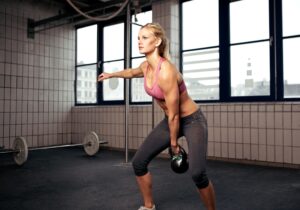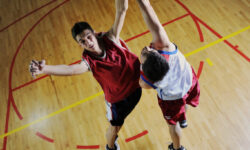
This is the third in the series on weight training, where we look at training that is not necessarily all about dumbbells and barbells. In this article we take a look at kettlebell training.
One of the advantages of kettlebell training over training with dumbbells is that you don’t need a wide range of kettlebells to create a great workout. Generally speaking, one 16kg kettlebell for a man and an 8kg kettlebell for a woman and you have the equipment necessary for a great workout. This is perfect if you cannot make the gym and need to do a workout at home.
First of all, what is a kettlebell?
Before we launch into the workout however, here is a little information for those of you who have not come across this brilliant piece of gym equipment before. At its most basic level, a kettle bell is a lump of iron that comes in several sizes. It can come with a plastic coat, but essentially it is like a bowling ball with a thick handle at the top.
You can use kettlebells for standard weight training exercises – bench presses, curls, rows – much as you would a dumbbell. But one of the exciting things about working out with kettlebells is the range of ballistic movements you can do, which means that you can work your muscles faster and develop fantastic muscular endurance. You will soon feel the benefit from using kettle bells and doing sets of fast reps of snatches, swings, cleans and jerks.
Kettlebells can be used to great effect in core work. The windmill is a move that involves lifting the kettlebell into a position with a straight arm held over your head, then sliding your free hand down towards the floor. This is an off-balance movement that will help develop rock-hard abdominals.

Developing core strength with kettlebell training
Likewise, the Turkish Get-up is a move that develops balance and core strength. Lie on the floor with the kettle bell held over your head with a straight arm. Keeping the arm straight and over your head, move to a standing position. Don’t rush the move but feel it working your hamstrings, flutes and abdominals.
You can do all of these exercises with dumbbells, but the beauty of the kettlebell is that it’s odd shape means you work harder to keep your balance while performing the repetitions, in particular you will be working those stabiliser muscles which often get neglected when you are doing isolated muscle work. According to research, a 20-minute kettlebell session can burn up to 300 calories and is effective as both an aerobic exercise workout or a strength and conditioning session.
Here is one great kettlebell training workout
For the following workout, do one set in the sequence without rest. Once you have completed a circuit, rest of 1-2 minutes then repeat for a total of three rounds.
Kettlebell Goblet Squat
Hold the kettle bell with both hands in front of you at waist height, drive your shoulder blades together and down, so your chest is open and your elbows are tucked in.
Your feet should be shoulder width apart with feet slightly turned out. Squat down as low as you can go, imagine twisting your feet into the ground as you do so, hold for a count of three then drive upwards. Repeat 12 times.
Kettle bell one-arm row
Place the kettlebell on the floor and take a staggered stance with your right foot in front. Your foot should be just outside the weight. Your legs are in a staggered lunge position. Rest your right elbow on your right thigh for support and then lift and lower the kettlebell slowly wth your left hand for eight reps. Repeat on the other side.
Kettle bell one-arm press
Stand tall holding the kettlebell in one hand at shoulder level. Feet are shoulder distance apart, with knees ‘soft’. Take a deep breath into your belly and brace your abs and glutes. Pull your ribs down and think “proud chest.”
Press the weight overhead with a vertical forearm. Note that your chin should be pulled back so that weight has no trouble clearing it. To lower the kettlebell, pull it back down into position—as if you were performing a pull up. Complete eight reps on one side and then repeat on the other side.
Kettlebell chest loaded swing
Stand with feet between hip and shoulder-width apart and hold the kettlebell by its handle, pulling the bottom of the bell into your chest. Draw your shoulder blades together and down (“proud chest”) and cast your eyes on a spot on the floor approximately 15 feet in front of you.
Take a deep breath and root your feet. Then bend from your hips until you feel a stretch in your hamstrings. Keep your spine long as you hold the move for three seconds. Squeeze your gluten and slowly rise back up to standing
Kettlebell single-arm squat to press
Hold the kettlebell with one hand at shoulder level. Tuck your elbow in so your forearm is vertical. Perform a squat, with feet about shoulder distance apart, lowering your legs until they are at 90 degrees. Then come up and press overhead all in one movement. Repeat eight times on each side.
Kettlebell halo
Stand with feet between hip and shoulder-width apart and hold the kettlebell by its handle upside down—the bell should face up. Screw your feet into the floor and draw your ribs down. Think “proud chest.”
Begin moving the kettlebell around your head, being careful to maintain your posture and not bend your torso in any direction. Move slowly to avoid whacking yourself in the head. Make full circles and alternate directions on each rep. Repeat 10 times.
You can vary this move by taking the kettlebell round the hips or round the knees
Kettlebell hip halo
Set up as you did for the shoulder halo but hold the kettlebell by the handle at arm’s length and make circles around your hips. Hand the kettlebell off from one hand to the other. Perform ten reps in one direction and then repeat in the opposite direction.
Kettlebell knee halo
As above, but move into a squat position and then make circles around the knees.
For more ideas on using the kettlebell for training, talk to one of the experienced instructors in the Outlooks Gym.







